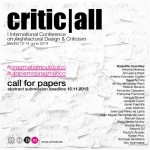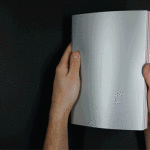critic|all – #out-tonomy | Call for Papers

The II International Conference on Architectural Design And Criticism critic|all, organized by the School of Architecture of Madrid within the framework of its Master’s Degree in Advance Architectural Design (MPAA-Departamento de Proyectos Arquitectónicos), will be held from 20 to 22 June 2016. This time, the proposed theme #out-tonomy aims to gather new perspectives on the debate about the disciplinary boundaries of architecture.
Details
Authors are invited to submit a 300 word abstract by December 10, 2015.
Abstracts can be written either in English or Spanish.
All received abstracts will go through a blind peer review. In the light of the 2 reports by the reviewers, the Scientific Committee will invite authors to submit a full paper. Depending on the amount of works submitted, the Scientific Committee will carry out a selection of papers for its oral presentation during the conference, to be held in June 20, 21 and 22, 2016.
To submit an abstract it is not necessary to be registered. Once the abstract has been accepted, it will be necessary to be registered to send the full paper.
Please visit www.criticall.es for detailed information.
Registration
Standard fee: 200 euros
Early-bird fee: 150 euros
Graduate student: 120 euros
Undergraduate student: 60 euros
MPAA#7 student: free
Call
The topic proposed for the second edition of Critic all is the autonomy of architecture, recollecting and reframing the reflections that over architecture’s specificity have been produced within the discipline itself. If there is an approach that argues that architecture cannot be an isolated medium, that is, autonomous – not only in regard to social culture but above all, the worldly social, political and economic environment in which it is immersed, – we also have to face those visions that, conversely, consider that architecture is strictly a self-referential discipline, and therefore, it employs a self-sufficient language whose verification is determined by a collection of predefined historical forms.
However, there is a single set of facts, ideas, forms and styles, one that grows larger over time. All this knowledge belongs to us and it may and should be interpreted as an architectural event. And there is an infinite number of paths for the interpretation of those facts, ideas, forms and styles. There are those which make use of new critical tools, alien to the instruments of the architectural discipline, inherited from other intellectual and scientific fields. Others, instead, reclaim the delimitation of the discipline itself to be the main scope of the critical task.
Modernism set up the replacement of an architectural discourse for that of science and technology, therefore emptying the place of architecture. As a response, Postmodern thought reinforced its mechanisms of signification by means of difference and identity, propelling the intensification of disciplinary self-referentiality that characterizes autonomy. Today we know that any discursive contribution cannot be fully constructed from its interior, whether absent or reasserted, but rather from the surroundings of architecture.
Once we passed the Millennium, the pragmatism that characterizes global capitalism questioned any critical discourse on autonomy for its lack of operational effectiveness, re-inscribing the critical discourse of architecture in a world without disciplinary, cultural, economic, geographical or political limits. Are the globalization model and the disciplinary autonomy self exclusive? Is it useful or even plausible to re-frame a concept of autonomy in the current context? Is it possible to give up the limits of disciplinary knowledge and yet preserve the identity and purpose of architecture?
Globalization extends through the economic, social, political, technological, warfare and ecological realms. As heir to Postmodernism, its distaste for Utopia and ideology promotes a concealed recognition of the status quo. If we were to re-draw once again the body of the architecture – its organs or even its anatomy – with the intention of discerning its identity in relation to the complex global interdisciplinarity, we should have to do it in the formless context of global realism and mass-media, removed from the art-object reification of architecture on which autonomy was predicated. Definitively, we ought to understand architecture as complex but not Utopian, transversal but not critical, operative and not abstract.
Thus we propose the term out-tomy as a framework to overcome such dichotomy. Discipline is no longer a place, or reserve that the ‘academy’ defines, setting a boundary between the self and the alien. It is a gaze, a reading or modification. It is a glance which, simultaneously directed outwards and inwards, is alien to the architectural discipline, yet also resonant with it.
The autonomy of architecture does not reside in its technologies or methodologies. Rather, it relies in its capacity to respond freed from pre-established theories, critically untethered to specific techniques, exclusively catering for the systematic, managed and chosen for each time. Such autonomy requires to position ourselves out of the matter we want to analyze, manipulate or produce, knowing, at the same time, that we cannot make decisions without being directly involved in that matter. Because nothing is done on things but between them.
Recognizing the paradox it involves, the term out-tomy proposes the combination of an internal autonomy, described from within as the preservation of a certain discipline delimited by memory, history and its specific techniques, with an external autonomy, that is defined from the outside and influenced by other fields and cultures, attentive to society, politics and economy – the forces that rule the world. Whilst they may overlap with each other, both concepts are merged into a specifically contemporary gaze through the suggested new term.
Lying between the desire of ‘unit’ and ‘self-referral order’ as a translation of the concept of discipline and the pursuit of ‘fragmentation’ and ‘autonomy of the parts’ as translation of the importance of the accurate and current, the dichotomy could be solved insofar as we recognize that both visions have created a situation where they no longer confront each other but simultaneously blend.
Such double condition enables to place ourselves at both sides of the limit, until we get to simultaneously see the interior and the exterior. The awareness of being inside because of looking from the outside and, conversely, of recognizing ourselves in the outside when seen from the inside, is a contemporary trait that we seek to collect, display and confirm at this conference.
All the info on www.criticall.es
Questo sito usa Akismet per ridurre lo spam. Scopri come i tuoi dati vengono elaborati.








Lascia un commento